The almost perfect lining material for bird nest cups.
Blog followers know that I occasionally rerun a favorite older blog post but this one is a little different. It’s actually a hybrid of sorts. It consists of portions of a post I published eight years ago, combined with new text and photos that weren’t included in the original post.
For millennia a variety of North American bird species used bison hair during nest construction but when the “buffalo” was brought to the brink of extinction by hunters in the late 1800’s that resource was essentially gone. Today there are very few places where bison hair is available to birds and Antelope Island is one of them.
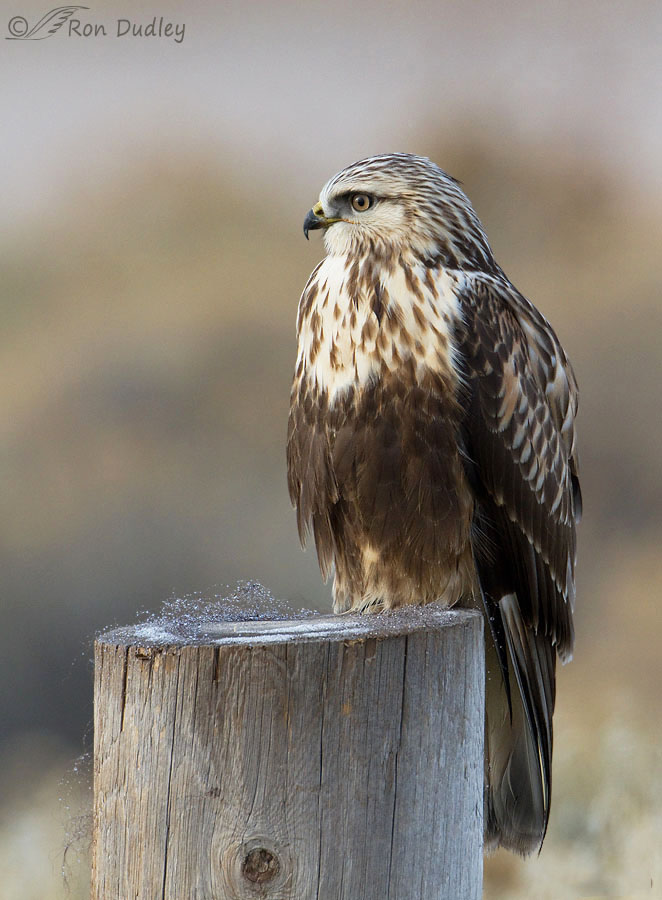
The 500+ bison on the island do a lot of scratching so almost anything vertical and solid can have bison hair stuck to it. The sturdy post this Rough-legged Hawk is perched on is a prime example – there’s bison hair on the top and left side of the post. It was a cold morning so much of the hair was covered with frost.
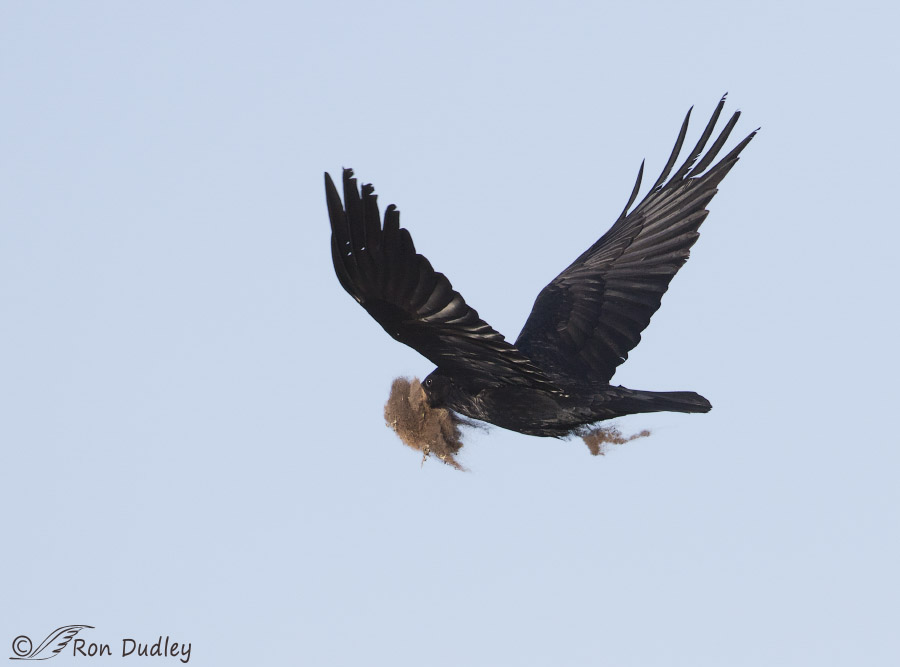
When nesting season rolls around a variety of birds take advantage of the bison hair bounty that they can collect at their leisure without having to steal it from a living bison. This is a grab shot of a Common Raven with a beakful of bison hair and some more hair attached to its feet. It’s a convenient coincidence for birds that nesting season coincides pretty closely with the time of year that bison (and other large mammals) are shedding their winter coats.
When birds use bison hair as nesting material they typically don’t use it to construct the more sturdy outer portions of their nests. Instead they use it to line the nest’s inner cup. Mammal hair is an excellent insulator and it’s soft.
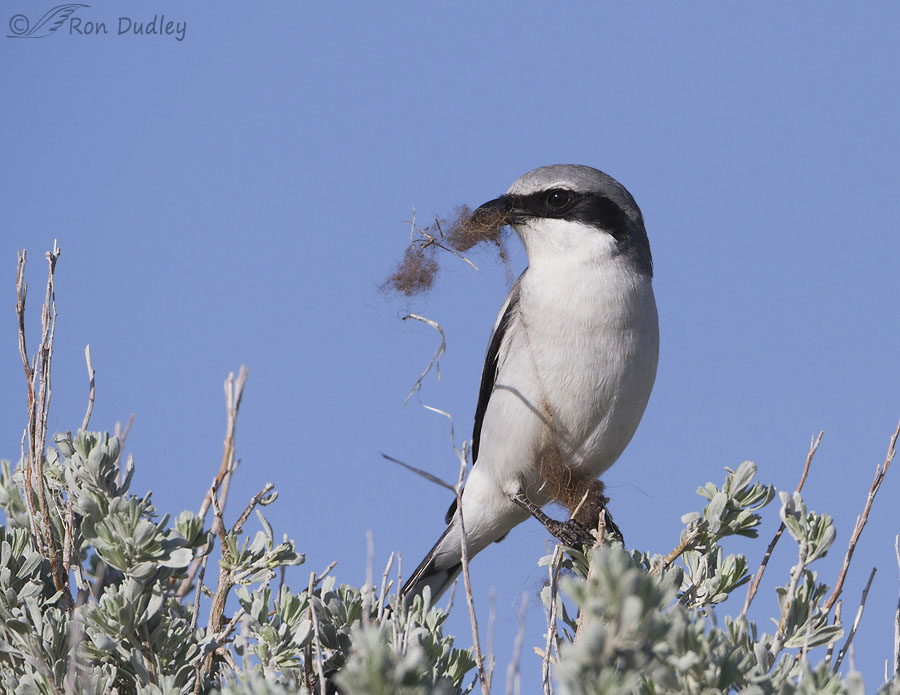
I photographed this Loggerhead Shrike seconds after it landed on top of the sagebrush its nest was in. Yup, that’s bison hair in its bill and strung all the way down to its feet.
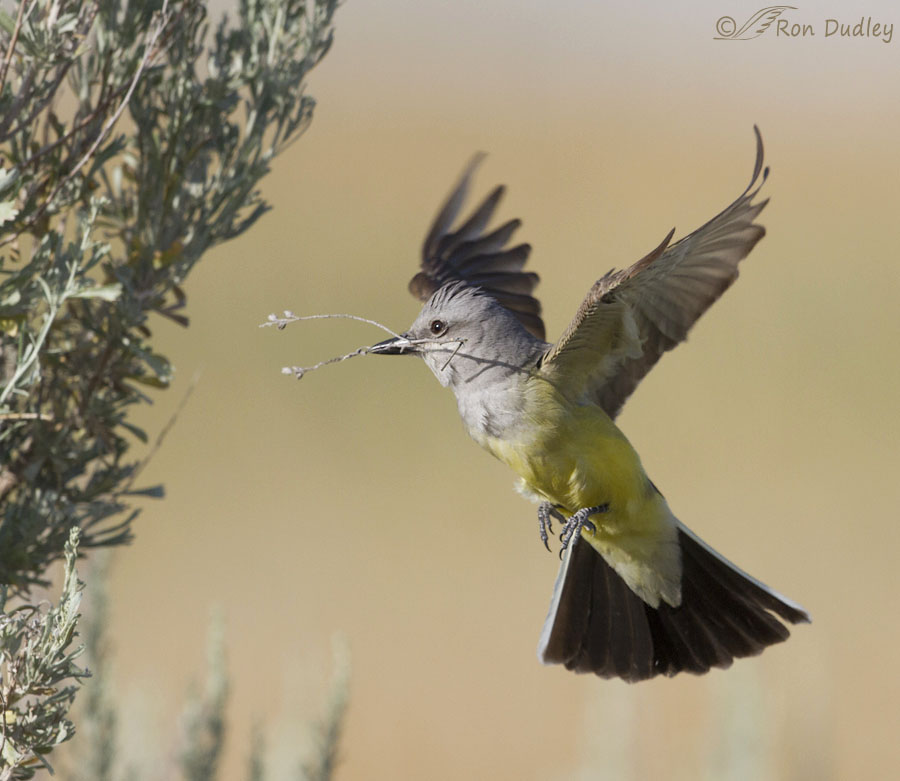
A few years ago I spent many hours with a pair of Western Kingbirds on the island as the female constructed their nest (only the female of the species builds nests) while her mate was usually perched nearby. For the first several days she brought in small twigs and grasses but there was an abrupt change in construction material when she began work on the lining of the nest’s inner cup.
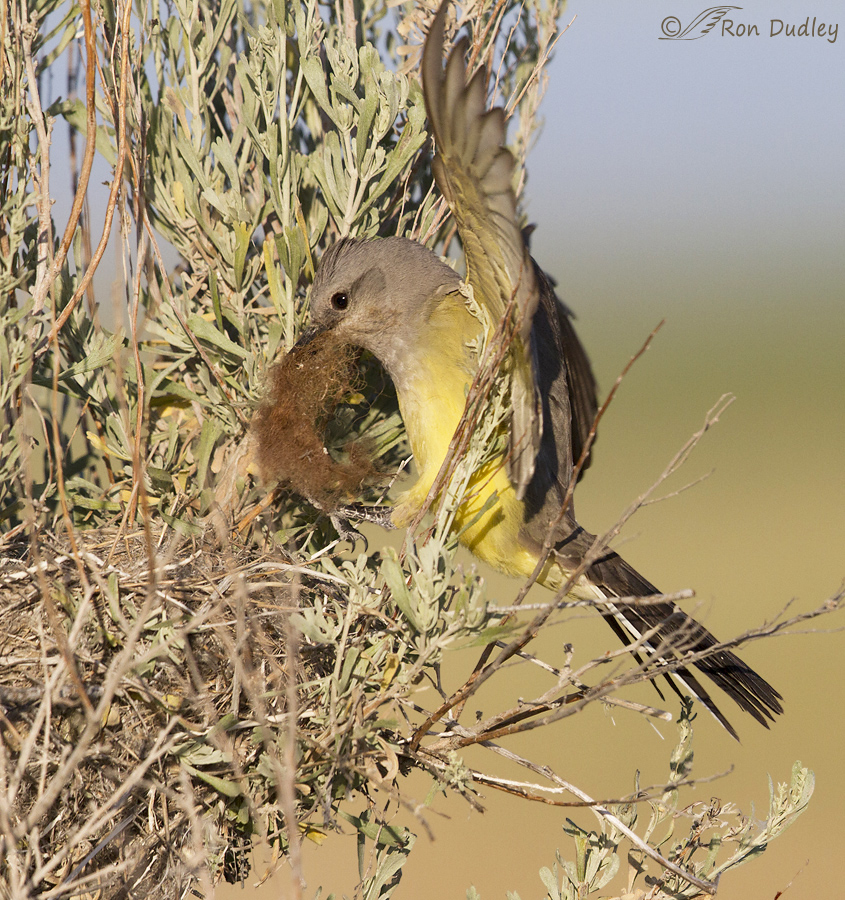
At that point her preferred nesting material became bison hair, pretty much exclusively. The bison on the island had recently completed shedding their heavy winter coats so their fur was a readily available resource, with clumps of it stuck to fences, large rocks and sign posts all over the island. Bison hair makes an ideal nest liner for its insulating, softness and comfort qualities.
At first it was difficult to tell what she was using to construct the nest because she usually disappeared into the nest so fast that I couldn’t identify the material. But then I made a concerted effort to photograph her just as she was landing and on my last day with her that material was usually bison hair.
That morning I was able to get three very similar photos as she brought in three different loads of bison hair. Because her landing posture and wing position were the same in all three images I clipped her wings in all three shots but the nesting material can easily be identified as bison hair.
This first photo has a golden glow because it was taken soon after sunrise and the light was very warm.
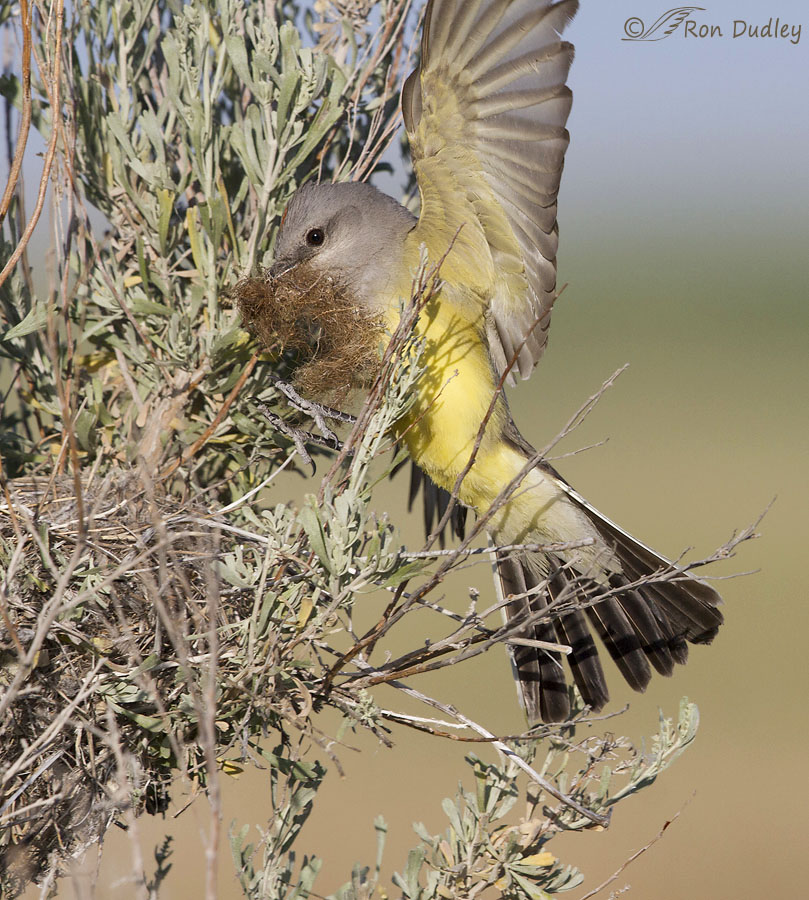
Twenty four minutes later I was able to get another shot where bison hair could be identified.
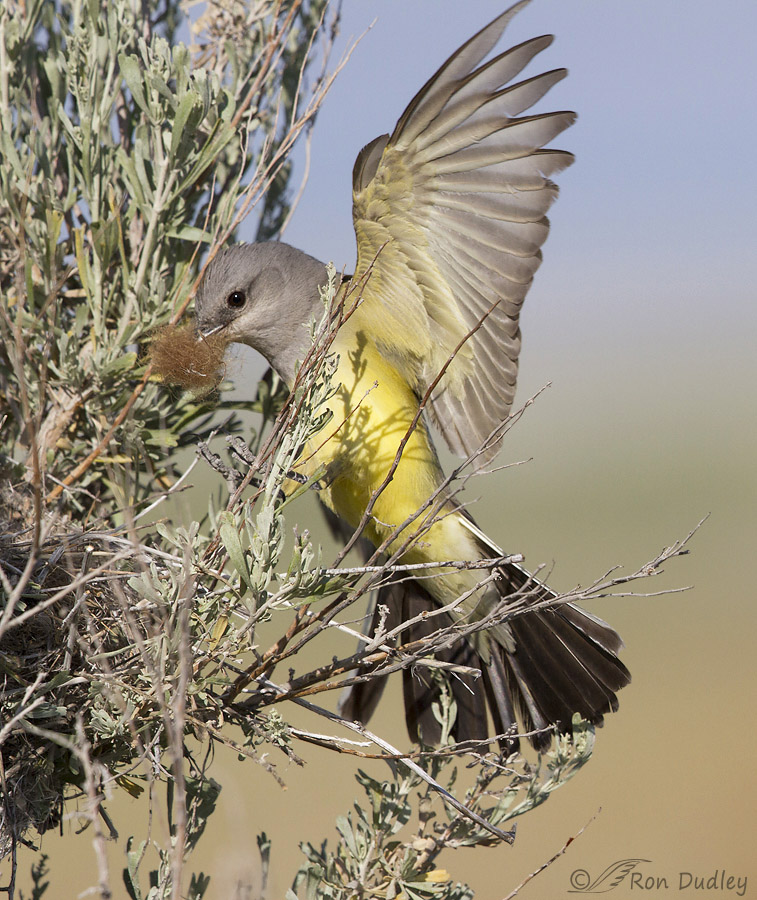
And 66 minutes after that I got another one. In-between she made many other trips to the nest with nesting material but even though most of the time I couldn’t identify what it was I’m confident that it was often bison hair. Maybe always.
Bison hair obviously makes a wonderfully effective and convenient nest lining material for a variety of birds and in recent years several commercial enterprises began to offer bison hair for sale to bird lovers as nesting material. One of them was BisonNest out of Colorado. A few years ago their graphic designer actually contacted me about use of the shrike photo above in their advertising but in the end it didn’t work out.
And I see that BisonNest’s website is no longer active so it must not have been a viable commercial enterprise.
Ron


Sensational informational series Ron!
Thank you, Charlotte.
Very neat collection of images. Growing up our neighbor was a horse breeder, trainer and judge at horse shows. His wife would cut the tails and manes of horses and wash and line dry the hair for extensions in show horses. I would watch mostly starlings, orioles and house sparrows take the hair as it was drying on the outdoor lines. Often it was comical because she attached the hair well to the line and the birds were determined.
That must have been fun to watch.
Lovely. When we had dogs we always left their hair outside for the birds when they were brushed. And now I leave the cat hair out. Both disappear quickly when the season is right.
And, on the connectness of nature, killing the bison was a crime, and others suffered badly too. I wonder what the birds turned to in the first years after the slaughter. And whether it was/is as good.
“I wonder what the birds turned to in the first years after the slaughter”
I don’t know but birds are pretty resourceful when it comes to nesting material. Ferruginous Hawks used to use bison bones for nest construction so they had to adapt too.
We saw plenty of “molty” bison when visiting Antelope Island just 12 days ago, so the supply for nesting birds is no doubt excellent this year! These are all wonderful photos, Ron (that Roughie is spectacular), and love the close-ups of Mama Kingbird in construction mode. You’d think, given its water-resistant qualities, that the bison hair would also make a good outer layer for nests, as well, but perhaps too “messy” for that purpose?
Sorry not sorry about your soggy weather (though I do feel for the birds)!
Chris, I suspect some birds, especially smaller ones, do use some bison hair for other parts of their nests.
We need this soggy weather desperately so I’m not complaining. But after nearly 3 days of it there’s only .6″ (6/10ths) of water in my rain gauge. Not nearly enough but it’ll help.
Love the pictures and postings by everyone. I heard at one time to use the dryer lint then was told not to use as when it got wet it would be bad in the nest. Ron have a nice day and the weeks to follow from your surgery.
I’ve heard conflicting things about dryer lint for nesting material too, Trudy. Thanks for the good wishes.
Any one of these photos could stand alone as the instructional and beautiful post you present to us. The older photo of the Western Kingbird holding a twig certainly invokes an image of another bird known as a symbol of peace.
With apologies to J. Mitchell:
Raven castles in the air,
Soft and warm with Bison hair.
Thanks very much, Lyle.
I’ve put dryer lint (no fabric softener” sheets in suet cages, and this Spring sphagnum moss in the branches of the Oak Tree. Both have been used extensively. The dryer lint often shows up lining the hummingbird nest.
Lovely, lovely posts.
Thanks, Jan. When it comes to nesting material, birds are certainly adaptable.
Unlike feathers, mammal hair retains most of its insulating qualities when wet. I don’t know how much that matters in places that are drier but it would really make a different in the eastern US.
” it would really make a different in the eastern US”.
Even here in the very dry west it would make a difference, Pam. Today is our third soggy day in a row (highly unusual for us) and I’ve been wondering how our nesting birds are faring.
I really appreciate the fact that you are willing to publish “imperfect” photos like those with clipped wings etc if it helps to tell a story or document a behaviour.
Granny Pat, when I’m documenting bird behaviors, flaws like clipped wings don’t bother me. Much…
Around here, all the nests in my yard (and there are a lot) are lined with Great Pyrenees dog hair.Got to use what’s on hand, I guess.
“Got to use what’s on hand, I guess”
Birds have no other choice.
Beautiful and educational post Ron. Outstanding photos of the Kingbirds using the hair to build their nests.
That first photo of the Rough-legged Hawk is really good and sharp.
Memorial Day greetings to you and all your blog followers.
Thanks, Everett. I wish you the same.
So lovely for the nestlings who hatch on Antelope Island– thanks for this
picture of a tiny bit of the ancient past…….
I’m glad you enjoyed it, Kris.
Very informative post and of course great photos! Gives me an idea – I spin yarn (and I don’t mean tall tales 😊) so I have some wool fiber remains that I could leave out for all the my feathered neighbors. The spring so far we have had House Finches Cardinals and Robins nesting in our arborvitae. The House Finches are starting a new nest the second brood now. Elsewhere in the yard there is a birdhouse with house wrens and a pair of cat birds. All in a quarter acre of various trees in the small semi-urban environment!
Thanks, Joanne. I’m envious of all the nesting birds in your yard.
Very interesting Ron. And great shots too!
Thank you, Michael.
Neat! The birds DO make use of what’s at hand. 🙂 I throw the brushings from the dog shedding it’s coat in the garden and several birds make use of that also. On the down side they’ll also use shredded plastic tarp strings/baling twine and other material not so biodegradeable that can tangle the young now and again.
Judy, I mostly remember traditional baling twine from the old days in Montana. I liked that stuff a lot better than the artificial materials they turned to later.
The synthetic stuff is nasty and stays around forever – hard on lawnmowers too….. 😉